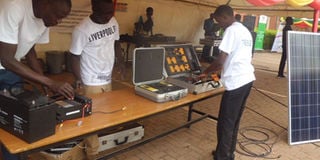Mak Energy Centre engages entrepreneurs in use of energy technologies

Technicians exhibit some of the equipment at the centre
Entrepreneurs interested in carrying out business along the energy sector with a focus on providing clean energy service to the people now have an avenue of getting ideas of emerging technologies from experts at Makerere University College of Engineering, Design, Art and Technology (CEDAT).
The Centre for Research in Energy and Energy Conservation (CREEC) at Makerere University is engaging engineers and students pursuing engineering courses in developing innovative technologies in areas of renewable energy such as cook stoves where both biomass and solar energy can be used, training kit service for entrepreneurs engaged in Solar installation as well as development of solar pumps for irrigation targeting small scale farmers among others.
Some of the products that are ready for sale to the public such as solar pumps, cook stoves and solar water heater among others were exhibited at the University during the launch of the East African Centre of Excellence for Renewable Energy and Energy Efficiency (EACREEE) which is housed at CEDAT.
Mr Robert Leny a solar technician at CREEC in explaining a tool kit which his team uses for training entrepreneurs engaged in using various solar equipment notes that usually companies dealing in solar installation approach them for training of their workers.
This is when the solar training device becomes useful because it can be used in testing solar equipment such as solar battery which may not be working efficiently.
This training provided to companies attracts different rates of a fee depending on the service provided.
A case in point is training in categories such as measurement of solar power consumption generation for one day goes at 250 US dollars about (Shs835, 000) and if it is one week it costs 550 US dollars (about Shs1.8 million). Measurement of panel characteristics costs 60 US dollars about (Shs200, 400) and on sight analysis of panel array costs 300 US dollars about (Shs1.1 million). Measurement of light output consumption of lights costs 80 US dollars about (Shs267, 200) and product test for lighting range from 300 to 500 US dollars.
The Germany based company Deutsche Gesellschaft für Internationale Zusammenarbeit (GIZ) that provide solar energy services for people living in various villages in the country is the key company whom the team has worked closely.
Other innovations include solar cook stoves where the user is entitled to place the panel at a position where there is sunshine for it to keep charging. The stove does not depend entirely on solar but fuel like pellets are used to heat the stove. Instead of using a lot of fuel wood, less is used because of the power supply from the solar panel. The general market price including the solar panel is Shs150, 000
Mr Godfrey Wangi a design engineer in the low cost irrigation scheme project at the University explains about the solar water pump saying his team manufactures the pumps the university which is sold to small scale farmers at Shs500, 000 minus the solar panel. A farmer who is willing to invest in this technology can spent between Shs2 million and 2.5 million and this includes solar pump, the panel and the water pipes plus the tank.
This technology according to the team will help farmers during times of drought and it provides clean system of water pumping compared to use of diesel where there are carbon emissions in the atmosphere. The solar pump is estimated to be delivering120 litres of water per minute at a range of 20 meters. Already there is a product ready for purchase at the university though they are in planning process of setting up a factory in Kampala with an intention of producing 5,000 pumps per year for supply to small scale farmers.
Another innovation which can be fulfilled upon making an order to the engineering students is developing a solar water heater. Stephen Bogere a fourth year engineering student says they have a water heater innovation project where they can make water heater with a capacity of 160 litres or more. It is called the solar basin and it costs between Shs2million up to Shs5million depending on the capacity. The team made one which they sold at Shs2million. It has a component of the solar panel attached which can be placed on any part of the compound depending on the direction of the sunshine.
Against this background of already existing innovations at the University, this is the reason why it is chosen as the centre of excellence for renewable energy and energy efficiency for the East African region.
The major objective is to cope with the global energy challenge faced by developing countries and those that are in transition.
In report by United Nations Industrial Development Organisations (UNIDO) giving statistical analysis of challenges faced in sustainable energy use by developing countries, it is stated that in the year 2030, 1.3 billion people in the globe may not have access to modern and affordable electricity. Today the figure stands at 2.7 billion people.
Out of the people living in developing countries 80% consume only 30% of the global energy supply. The poor spent more income for poor quality energy service with many of them relying on biomass for cooking.
Further statistics shows that in the year 2030 cities may consume more than 73% of the global energy generated therefore the rapidly growing urban electricity demands needs major investment in energy infrastructure in developing countries with solar energy being a major source.
Since 80% of the global energy supply is from fossil fuels generated from coal, oil and gases, this result to 66% of the global carbon emissions leading to rise in global temperatures. This is the reason why entrepreneurs need to engage in sell of energy equipment providing clean energy.




